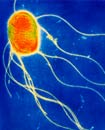Salmonella enterica: foodborne illness: Difference between revisions
No edit summary |
No edit summary |
||
| Line 1: | Line 1: | ||
{{Curated}} | {{Curated}} | ||
The bacteria Salmonella is commonly associated with food poisoning in countries all over the world. There are two species of Salmonella: S. enterica and S. bongori. However, the species that most people refer to when they talk about Salmonella is S. enterica. This species is divided into a subset comprising of serovars. In S. enterica alone, there are over 2,000 serovars of bacteria. The most common cause of food poisoning is associated with the serovar S. Enteritidis. These outbreaks are attributed to unsanitary meat preparation that can be traced as far back to the farm where the poultry or beef were raised. Salmonella enteritidis is a rod-shaped, gram-negative, proteobacteria that is non-motile. These facultative anaerobes are well adapted to survive in condition with our without oxygen, allowing them to live in diverse environments. However, Salmonella enteritidis are usually found within animal hosts where they can be transmitted easily through food processing or fecal matter in areas with poor sanitation. | The bacteria Salmonella is commonly associated with food poisoning in countries all over the world. There are two species of Salmonella: S. enterica and S. bongori. However, the species that most people refer to when they talk about Salmonella is S. enterica. This species is divided into a subset comprising of serovars. In S. enterica alone, there are over 2,000 serovars of bacteria. The most common cause of food poisoning is associated with the serovar S. Enteritidis. These outbreaks are attributed to unsanitary meat preparation that can be traced as far back to the farm where the poultry or beef were raised. | ||
<br>Salmonella enteritidis is a rod-shaped, gram-negative, proteobacteria that is non-motile. These facultative anaerobes are well adapted to survive in condition with our without oxygen, allowing them to live in diverse environments. However, Salmonella enteritidis are usually found within animal hosts where they can be transmitted easily through food processing or fecal matter in areas with poor sanitation. | |||
[[Image:salmonella_sm.jpg|thumb|1000px|right|[Figure 1]Salmonella enterica serovar Enteritidis.[http://www.google.com/imgres?imgurl=http://www.microbiologyonline.org.uk/themed/sgm/img/page-backgrounds/salmonella_sm.jpg&imgrefurl=http://www.microbiologyonline.org.uk/about-microbiology/microbes-and-the-human-body/routes-of-transmission%3Fstyle%3Dlarge&usg=__Dvz_LsJ6CATZf1n60QznRyn1LHE=&h=130&w=105&sz=5&hl=en&start=60&zoom=1&tbnid=69wDnT_L_RgrkM:&tbnh=104&tbnw=84&ei=jQCzTf2iN6r40gGasPngDA&prev=/search%3Fq%3Dsalmonella%2Benteritidis%26um%3D1%26hl%3Den%26client%3Dsafari%26sa%3DN%26rls%3Den%26biw%3D1024%26bih%3D616%26tbm%3Disch0%2C1792&um=1&itbs=1&iact=rc&dur=543&page=5&ndsp=16&ved=1t:429,r:2,s:60&tx=38&ty=48&biw=1024&bih=616].]] | [[Image:salmonella_sm.jpg|thumb|1000px|right|[Figure 1]Salmonella enterica serovar Enteritidis.[http://www.google.com/imgres?imgurl=http://www.microbiologyonline.org.uk/themed/sgm/img/page-backgrounds/salmonella_sm.jpg&imgrefurl=http://www.microbiologyonline.org.uk/about-microbiology/microbes-and-the-human-body/routes-of-transmission%3Fstyle%3Dlarge&usg=__Dvz_LsJ6CATZf1n60QznRyn1LHE=&h=130&w=105&sz=5&hl=en&start=60&zoom=1&tbnid=69wDnT_L_RgrkM:&tbnh=104&tbnw=84&ei=jQCzTf2iN6r40gGasPngDA&prev=/search%3Fq%3Dsalmonella%2Benteritidis%26um%3D1%26hl%3Den%26client%3Dsafari%26sa%3DN%26rls%3Den%26biw%3D1024%26bih%3D616%26tbm%3Disch0%2C1792&um=1&itbs=1&iact=rc&dur=543&page=5&ndsp=16&ved=1t:429,r:2,s:60&tx=38&ty=48&biw=1024&bih=616].]] | ||
<br><br><br> | <br><br><br> | ||
Revision as of 17:27, 23 April 2011
The bacteria Salmonella is commonly associated with food poisoning in countries all over the world. There are two species of Salmonella: S. enterica and S. bongori. However, the species that most people refer to when they talk about Salmonella is S. enterica. This species is divided into a subset comprising of serovars. In S. enterica alone, there are over 2,000 serovars of bacteria. The most common cause of food poisoning is associated with the serovar S. Enteritidis. These outbreaks are attributed to unsanitary meat preparation that can be traced as far back to the farm where the poultry or beef were raised.
Salmonella enteritidis is a rod-shaped, gram-negative, proteobacteria that is non-motile. These facultative anaerobes are well adapted to survive in condition with our without oxygen, allowing them to live in diverse environments. However, Salmonella enteritidis are usually found within animal hosts where they can be transmitted easily through food processing or fecal matter in areas with poor sanitation.

Salmonella enterica
Putrefaction
Include some current research in each topic, with at least one figure showing data.
Prevention
The most effective way to prevent Salmonella infections is to thoroughly cook all meats. The United States Department of Agriculture has also published guidelines to prevention. These include washing your hands and cooking surfaces often as well as washing hands, cooking utensils, and cooking surfaces with hot, soapy water before handling any food. Because red meat, poultry, and seafood are more susceptible to carrying Salmonella, they also recommend separating these foods from other food in your refrigerator. Cooking at proper temperatures and refrigeration are important steps in preventing Salmonella outbreaks.
Conclusion
Overall paper length should be 3,000 words, with at least 3 figures.
References
Edited by student of Joan Slonczewski for BIOL 238 Microbiology, 2009, Kenyon College.
